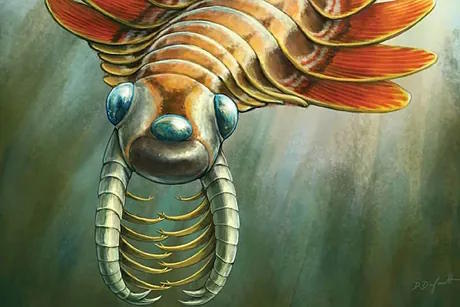A group of paleontologists has discovered an extraordinary predator from 506 million years ago in Canada that belonged to the extinct group of radiodonts, as reported by Europa Press. The Mosura fentoni was approximately the size of an index finger and had three eyes, articulated and spiny claws, a circular mouth with teeth, and a body with swim fins on the sides.
It was a relative of the famous Anomalocaris canadensis, a one-meter-long predator that shared the waters with the Mosura. The research is published in the Royal Society Open Science.
However, the Mosura also had a feature not observed in any other radiodont: a body region resembling an abdomen, composed of multiple segments at its posterior end.
"Mosura has 16 compact segments, lined with gills, at the back of its body. This is a clear example of evolutionary convergence with modern groups, such as horseshoe crabs, woodlice, and insects, which share a set of segments with respiratory organs at the back of the body," states Joe Moysiuk, Curator of Paleontology and Geology at the Manitoba Museum, who led the study.
The reason for this intriguing adaptation remains uncertain, but researchers suggest it could be related to a particular habitat preference or behavioral characteristics of Mosura that required more efficient respiration, as reported by Eureka Alert.
With its broad swim fins near the midsection and narrow abdomen, Mosura was nicknamed 'marine moth' by field collectors, based on its vague moth-like appearance. This inspired its scientific name, which references the fictional Japanese kaiju also known as Mothra.
Only distantly related to real moths, as well as spiders, crabs, and millipedes, Mosura belongs to a much deeper branch of the evolutionary tree of these animals, collectively known as arthropods.
"Radiodonts were the first group of arthropods to diversify on the evolutionary tree, providing key information about the ancestral traits of the entire group. The new species highlights that these early arthropods were already surprisingly diverse and adapted comparably to their distant modern relatives," states study co-author Jean-Bernard Caron, Curator of Invertebrate Paleontology at the ROM (Royal Ontario Museum).
Several Mosura fossils also show details of internal anatomy, including elements of the nervous system, circulatory system, and digestive tract.
Instead of having arteries and veins like us, Mosura had an open circulatory system, with its heart pumping blood into large internal body cavities called sinuses. These well-preserved sinuses of Mosura's circulatory system help us interpret similar, albeit less clear, features we have observed in other fossils. Their identity has been controversial - adds Moysiuk, also a research associate at the ROM. It turns out that the preservation of these structures is widespread, confirming the ancient origin of this type of circulatory system.
Of the 61 Mosura fossils, all but one were collected by the ROM between 1975 and 2022, mainly from the Raymond Quarry in Yoho National Park, British Columbia. Some also come from new areas around Marble Canyon in Kootenay National Park, 40 km southeast, which have revealed spectacular new Burgess Shale fossils, including other radiodonts: Stanleycaris, Cambroraster, and Titanokorys. An unpublished specimen of Mosura collected by Charles Walcott, the discoverer of Burgess Shale, was also studied.
The Burgess Shale fossil sites are located within Yoho and Kootenay National Parks. The Burgess Shale was declared a UNESCO World Heritage Site in 1980 due to its exceptional universal value and is now part of the Canadian Rocky Mountain Parks World Heritage Site, a larger site.
